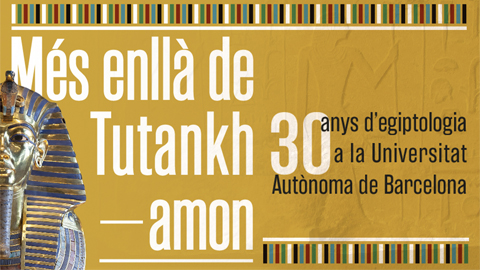The UAB to present the exhibition "Beyond Tutankhamon. 30 Years of Egyptology at the UAB"
The University offers this exhibition with the aim of commemorating 30 years of academic and research activities related to Egyptology, 100 years since the discovery of the tomb of Tutankhamon, and 200 years since the deciphering of the hieroglyphics, all celebrated this year. The exhibition will be on display from 3 November to 20 December, from Mondays to Fridays, 10 a.m. to 7 p.m., at the UAB Exhibitions Hall, located at the Communication Library and General Newspaper Archives. The UAB is the only university in Catalonia to offer university level studies in Egyptology and the only in Spanish-speaking regions to offer degrees and subjects in this field at all education levels.

The Universitat Autònoma de Barcelona began offering the first Egyptian language and history classes in 1992. It is now commemorating 30 years since the beginning of these studies with an exhibition entitled "Beyond Tutankhamon. 30 Years of Egyptology at the UAB", on the University's contributions to Egyptology through teaching and research, which has led to the training of specialists from all around Spain and has also contributed to reaching some important milestones. This anniversary coincides with two important feats in Egyptology: 200 years since the hieroglyphics were successfully deciphered, and 100 years since the discovery of Tutankhamun's tomb, which will also form part of the exhibition.
The exhibition was commissioned to Josep Cervelló and José Lull, lecturers of the Department of Antiquity and Middle Age Studies and researchers of the UAB's Institute for Ancient Near Eastern Studies (IEPOA). It is structured into informative panels with high-quality images, which are accompanied by an exhibition of research materials, such as the archaeologists' field journals and tools used in the excavations, and audiovisual projections of the research campaigns conducted by UAB researchers in Egypt.
The first two parts of the exhibition, with texts by lecturers Josep Cervelló, director of the IEPOA, and José Lull, are dedicated to the history and impact the deciphering of the hieroglyphics have had on Egyptology, made possible by Jean-François Champollion on 14 September 1822, and the discovery of Tutankhamon's tomb by Howard Carter on 4 November 1922. These historical feats were of transcendental relevance for the birth and recognition of Egyptology as a specialised field of knowledge within the area of antiquity studies.
A third part covers the history of Egyptology studies offered at the UAB since the 1990s. Thirty years in which this discipline had been present in the University's academic offer and which has evolved until becoming an official master's degree in Egyptology, an Egyptology and Ancient Oriental Studies line of the PhD programme in Studies in Antiquity and the Middle Ages, and a UAB-specific graduate diploma. In addition, the UAB's academic offer includes three massive open online courses (MOOC) and online specialisation courses offered directly by IEPOA, which has allowed thousands of people in Spanish-speaking parts of the world to discover and acquire more knowledge in Egyptology. Currently, the UAB is the only university in Catalonia and in Spain to offer university level studies in Egyptology, and the only in Spanish-speaking regions to offer degrees and subjects in this field at all university education levels.
The fourth part of the exhibition focuses on the UAB's contributions, through research projects in Egypt, to the knowledge generated about the history, social organisation, well-known figures and archaeological registries of Egyptian civilisation, as well as the conservation of its artistic and cultural conservation.
On the one hand, there will be the Spanish-Egyptian mission in South-West Saqqara, at the Kom el-Khamaseen site, directed by lecturer Josep Cervelló, who since 1997 has been working at the site with the objective of revealing the secrets and at the same time preserve the remains, of this necropolis, raided numerous times, and of other nearby sites. Among the most outstanding discoveries made by the UAB's research team are the tomb of Imephor, the High Priest of Memphis, capital of Egypt in the 3rd millenia BCE, as well as artifacts and inscriptions found in the tomb's funerary chambera, a foundational deposit and over one hundred unique statuettes of this important figure.
On the other hand, the lifeline of the Sikait Project, which began in 2016, will be on display. The project is directed by Joan Oller, also lecturer at the UAB. Located in the Wadi Sikait site of the Egyptian Eastern Desert, it is made up of a large nucleus of emerald mines exploited by the Roman Empire from the 1st to 6th centuries BCE and some 200 structures, including four magnificantly preserved temples. The research team obtained the first conserved image of a Roman emerald mine and recovered several materials associated to the world of Roman rituals. Under that same project, at the Greco-Roman port of Berenike, the team had found a small Egyptian temple in which they discovered a never-before-seen ritual with falcons.
"Beyond Tutankhamon. 30 Years of Egyptology at the UAB" will be on display from 3 November to 20 December, Mondays to Fridays from 10 a.m. to 7 p.m., at the Exhibitions Hall of the UAB Communication Library and General Newspaper Archives, located at the Bellaterra campus.